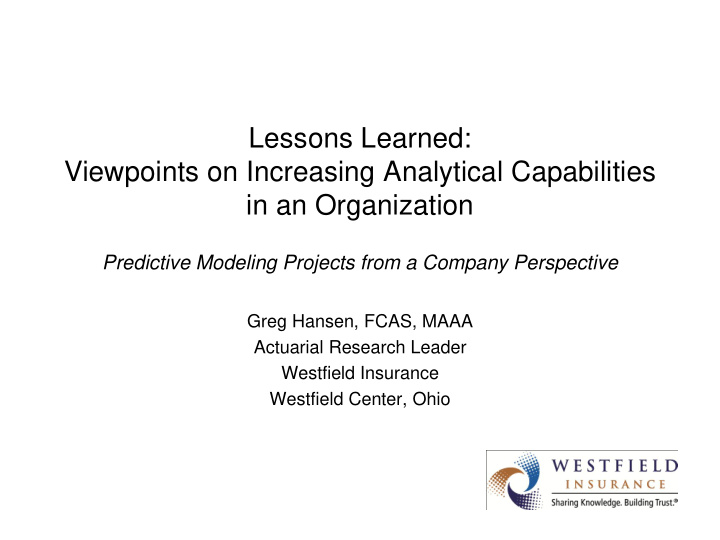



Lessons Learned: Viewpoints on Increasing Analytical Capabilities Lessons Learned (the Hard Way) in an Organization from Predictive Modeling Projects Predictive Modeling Projects from a Company Perspective Greg Hansen, FCAS, MAAA Actuarial Research Leader Westfield Insurance Westfield Center, Ohio
Westfield Insurance • Founded in 1848 • ~$1.5 Billion Direct Written Premium – $0.9 Billion Commercial / Surety – $0.6 Billion Personal • Produces business exclusively through independent agencies
A Basic Modeling Process Business Purpose Data Model Implement Monitor and Maintain
Lesson One • Modeling projects don’t begin with modeling. They begin with: – A business question / strategic goal – Research / data collection • Modeling projects don’t end with a model. They end with: – IT implementation – Business implementation – Monitoring and Maintenance • (a.k.a. “living with the models”)
Business Implementation Monitoring Report: Underwriting Model Utilization 90% Models rolled out Implemented Raised Perf. Performance Standard 85% Standard 80% 75% 70% 65% 60% 2007 2007 2007 2007 2008 2008 2008 2008 2009 2009 2009 2009 Q1 Q2 Q3 Q4 Q1 Q2 Q3 Q4 Q1 Q2 Q3 Q4
A Basic Modeling Process Data Model Implement Scaled to Actuarial Effort
Lesson Two • Modeling can be a small part of even the actuarial / modeling project Expect to do a lot more than just modeling
A Basic Modeling Process Data Model Implement Scaled to Total Project Effort
Lesson Three • Modeling is a tiny portion of the total modeling project – Recent (large) project: • Estimated Actuarial Hours: 6,000 • Estimated IT / Business Hours: 25,000 Make decisions based on the total scope of the project
A Tale of Two Projects • Two actual projects that I’ve managed over the last several years – Comparable scope – Comparable cost – Comparable expected business value – Both were ultimately successful – Biggest difference: time to complete
Project A 12 months 6 m 20 months Total Duration: 40+ months Project B 6 m 2 12 months Total: 12 months Data Model Implement
Lesson Four • Project A: Project manager not engaged until after the model was built • Project B: Project manager engaged before the project started Effective and timely project management is critical
Lesson Five • Project A: IT work did not start until months after the model was built • Project B: IT work ran concurrently with the model building process Begin communication between IT, modeling, and business units early
Lesson Six • Project A: Model was built entirely in- house • Project B: Used experienced consultants with whom we had an established relationship The right partners can help you get done faster (and better)
Lesson Seven • Project A: Model built “on the side” by part time resources • Project B: Had full time staff from day one (on both the company and the consulting side) Unless time is no issue, don’t try to build models “on the side”
Lesson Eight • Project A: The first project of its kind for our company • Project B: The fourth project of its kind It gets easier over time Look for repeatable processes
Lesson Nine • Project A: Was not a corporate priority until the modeling portion was complete • Project B: Was a corporate priority before the project started Models should to be driven by a business purpose (see Lesson One)
Closing Thoughts • Don’t forget about culture change – Effective communication and reporting • View wild claims of benefits with skepticism • Building a model has different challenges than owning one • Each project brings new challenges, new lessons
Recommend
More recommend